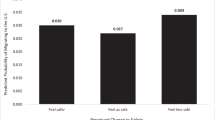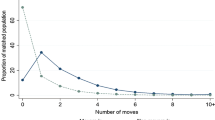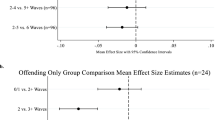Replacement respondents who move into NCVS households after the initial bounding interview can introduce measurement error since their reports of victimization may be influenced by their mobility (actual experiences) and by their unbounded interview status (response error). Which of these factors affects reporting is unknown and is the focus of this research. The availability of incoming respondent data from the NCVS School Crime Supplement and mobility status from the NCVS provides a unique opportunity to study these effects separately. Both bounding and mobility were found to influence reporting; however, this influence was not consistent. Unlike findings from past research, bounding only had significant effects on reports of property victimization. Conversely, moving only significantly affected reports of violent victimization. As this study is the first to disentangle the effect of unbounded interview status from mobility on reports of victimization, the findings emphasize the need for further research to better understand these issues.
Similar content being viewed by others
References
L. A. Addington (2000) Examining the Use of Bounded Interviews in the National Crime Victimization Survey Presentation at the Fifty-second Annual Meeting of the American Society of Criminology San Francisco, California
L. A. Addington S. A. Ruddy A. K. Miller J. F. DeVoe (2002) Are America’s Schools Safe? Students Speak out 1999 School Crime Supplement Statistical Analysis Report U.S. Department of Education Washington, DC
R. Bachman B. M. Taylor (1994) ArticleTitleThe measurement of family violence and rape by the redesigned National Crime Victimization Survey Just. Quar 11 499–512
Biderman, A., and Cantor, D. (1984). A longitudinal analysis of bounding, respondent conditioning and mobility as sources of panel bias in the National Crime Survey. In Proceedings of the American Statistical Association, Survey Research Methods Section. American Statistical Association, Washington, DC
Biderman, A., and Lynch, J. P. (1981). Recency bias in data on self-reported victimization. In Proceedings of the American Statistical Association, Social Statistics Section. American Statistical Association, Washington, DC
A. Biderman J. P. Lynch (1991) Understanding Crime Incidence Statistics: Why the UCR Diverges from the NCS Springer New York
Cantor, D., and Lynch, J. P. (2000). Self-report surveys as measures of crime and criminal victimization. In Duffee, D. (ed.), Criminal Justice 2000: Measurement and Analysis of Crime and Justice, U.S. Department of Justice, Washington DC.
de Leeuw, E., and Collins, M. (1997). Data collection methods and survey quality: An overview. In Lyberg, L., Biemer, P., Collins, M., de Leeuw, E., and Dippo, C. (eds.), Survey Measurement and Process Quality, John Wiley and Sons, Inc., New York.
L. Dugan (1999) ArticleTitleThe effect of criminal victimization on a household’s moving decision Criminology 37 903–930
D. W. Hosmer S. Lemeshow (2000) Applied Logistic Regression EditionNumber2 John Wiley and Sons, Inc New York
C. Kindermann J. P. Lynch D. Cantor (1997) The Effects of the Redesign on Victimization Estimates: Data Brief Bureau of Justice Statistics Washington, DC
R. G. Lehnen W. G. Skogan (1981) The National Crime Survey: Working Papers (Volumes 1 and 2) U.S. Department of Justice Washington, DC
J. L. Lauritsen J. H. Laub R. J. Sampson (1992) ArticleTitleConventional and delinquent activities: Implications for the prevention of violent victimization among adolescents Violence Vict 7 91–108 Occurrence Handle1419927
E. Loftus W. Marburger (1983) ArticleTitleSince the eruption of Mt. St. Helens, has anyone beaten you up? Improving the accuracy of retrospective reports with landmark events Memory Cognition 11 114–120 Occurrence Handle6865744
S. L. Lohr (1999) Sampling: Design and Analysis Duxbury Press Pacific Grove, CA
L. Murphy C. Cowan (1984) Effects of bounding on telescoping in the National Crime Survey R. Lehnen W. Skogan (Eds) The National Crime Survey: Working Papers (Vol. II) U.S. Department of Justice Washington, DC
J. Neter J. Waksberg (1964) ArticleTitleA study of response errors in expenditures data from household interviews J. Am. Stat. Assoc 59 17–55
Planty, M. (2003). An examination of adolescent telescoping: Evidence from the National Crime Victimization Survey. Fifty-eighth Annual Meeting of the American Association of Public Opinion Researchers, Nashville, Tennessee.
W. G. Skogan (1981) Issues in the Measurement of Victimization U.S. Department of Justice Washington, DC
S. Sudman A. Finn L. Lannom (1984) ArticleTitleThe use of bounded recall procedures in single interviews Public Opinion Quart 48 520–524 Occurrence Handle10.1086/268847
InstitutionalAuthorNameU.S. Census Bureau (2000) National Crime Victimization Survey: Interviewing Manual for Field representatives (Working draft) U.S. Census Bureau Washington, DC
InstitutionalAuthorNameU.S. Department of Justice. (1997) Criminal Victimization in the United States, 1994 U.S. Department of Justice Washington, DC
InstitutionalAuthorNameU.S. Department of Justice (1998) National Crime Victimization Survey: School Crime Supplement 1995 (Codebook) Inter-university Consortium for Political and Social Research Ann Arbor, MI
InstitutionalAuthorNameU.S. Department of Justice (2001) National Crime Victimization Survey (Codebook) Inter-University Consortium for Political and Social Research Ann Arbor, MI
H. Woltman J. Bushery L. Carstensen (1984) Recall bias and telescoping in the National Crime Survey R. Lehnen W. Skogan (Eds) The National Crime Survey: Working papers NumberInSeries(Vol. II) U.S. Department of Justice Washington, DC
Author information
Authors and Affiliations
Corresponding author
Rights and permissions
About this article
Cite this article
Addington, L.A. Disentangling the Effects of Bounding and Mobility on Reports of Criminal Victimization. J Quant Criminol 21, 321–343 (2005). https://doi.org/10.1007/s10940-005-4274-5
Issue Date:
DOI: https://doi.org/10.1007/s10940-005-4274-5




